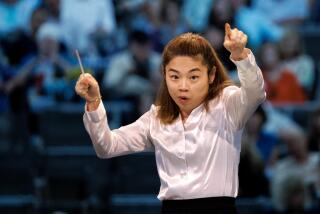Your piano teacher never showed you this
IN mankind’s never-ending quest for novelty, the piano has been strummed, hammered and plucked. But bowed?
“Yes, bowed,” says Stephen Scott, founder (in 1977) and director of the Bowed Piano Ensemble, based at Colorado College, where he has taught since 1969. “One of the first questions I get asked about it is: ‘So how do you get the piano under your chin?’ ”
Joking aside, Scott describes a bowed piano as “a 9-foot concert grand with the lid removed and many preparations added to it, played by an ensemble of 10.”
This “ensemble of 10” (dectet) -- faculty member Scott, eight students and an alumnus -- will be featured as part of the Pacific Symphony’s annual American Composers Festival. In line with the festival’s theme of “The West: Music Inspired by the American Frontier” and the concert’s program, “An American Tale,” ensemble and orchestra will offer the world premiere of Scott’s “Pacific Crossroads.” In it, six mostly historical figures cross the timeline to come together in Southern California, “which is an important part of the West,” Scott points out.
The Bowed Piano Ensemble will also perform “Sun Catcher,” from Scott’s hourlong “Vikings of the Sunrise.”
Commissioned by the Pacific Symphony, “Pacific Crossroads” is a 15-minute concerto-like work in which the bowed piano is the “soloist.” The players move about the piano -- “Gracefully and without any collisions,” Scott adds -- in order to “bow” its strings.
“The ‘bowed’ part refers to the three different kinds of ‘bows’ we use,” Scott explains.
“For soft, sustained tones, we use a nylon fish line that’s resined and rubbed under the string of the piano.
“For short, choppy tones, we use a stick of wood or tongue depressor, with horsehair or nylon fastened to it, resined and rubbed against the side of the string.
“Then there’s the bow made of plexiglass, either rough or resined, producing tones with sharp attacks and long decays on top of the string.”
Other “tools” include guitar picks, wooden and yarn percussion mallets, and hand-held piano hammers, using either the felt or wooden side. The damper pedal is usually kept down for resonance and the keyboard is almost never used.
So how will Scott & Co., who play from memory, fare coordinating their part with those of the orchestra?
“It’ll be a challenge to work with an orchestra and a conductor,” acknowledges Scott, who wrote only one other work for bowed piano and orchestra, a concerto. “I’m sure [conductor] Carl [St.Clair] and I will have numerous discussions. I’m a little nervous, but I know we’ll work it out just fine.”
--
--
BOWED PIANO ENSEMBLE
WHERE: Segerstrom Hall, Orange County Performing Artscenter, Town Center Drive, Costa Mesa
WHEN: 8 p.m. today, Friday and Saturday
PRICE: $25-$95
INFO: Contact: (714) 755-5799; www.Pacific Symphony.org
More to Read
The biggest entertainment stories
Get our big stories about Hollywood, film, television, music, arts, culture and more right in your inbox as soon as they publish.
You may occasionally receive promotional content from the Los Angeles Times.










